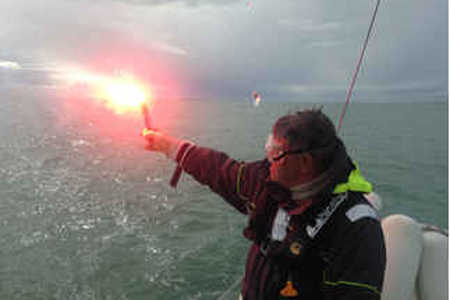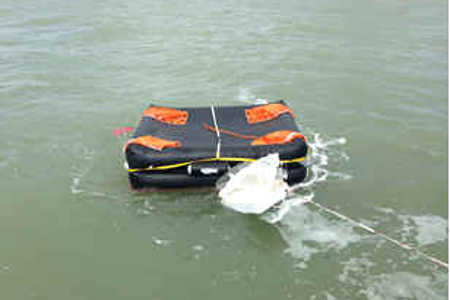Here’s an interesting aspect inherent to the practice of sailing! But what is it really, and why does it change so often? I am often asked this question during courses dedicated to safety in sailing,
"And if you fall overboard, what should we do?"
Just imagine for a moment, the skipper aboard a sailboat falls overboard with a crew made up of tourists who have no knowledge of sailing or sufficient understanding of how to use the VHF radio. To make matters worse, the skipper who fell into the sea wasn’t wearing a life jacket! This scenario could happen hundreds of times along our coasts, islands, and overseas territories... and it would most likely have a tragic outcome. Now add to this scenario darkness, strong winds, powerful waves... and stress! Suffice it to say, it’s a lost cause.
Cruising sailing schools aim to train future sailors in search of thrills, escape, and freedom. In this training, we learn to rig, tack, luff, and navigate. It is absolutely essential to understand and assess the risks associated with sailing. I would like to talk to you about prevention and forecasting, and therefore about passive safety and active safety. In passive safety, risks must be anticipated by taking precautions beforehand. In active safety, action must be taken once the risk occurs, using preventive measures adapted to all situations (water ingress, fire, man overboard, etc.).


This encompasses all measures taken to prevent the emergence of a risk. These measures largely pertain to the following areas:
Weather and tides inevitably impact navigation. As a volunteer with the SNSM, I often witness both seasoned and less experienced sailors running aground in areas where special attention should have been paid due to the falling tide. During the summer season, it happens almost daily. It is crucial to understand tidal calculations, especially when dealing with tidal ranges exceeding 5 meters.
Weather can also warn of potentially complex situations. Before setting out to sea, and as a preventive measure, make sure to check the weather forecast well in advance. Today, numerous websites are available to help you plan your navigation safely. The best approach is to compare at least two websites to confirm the information provided. And, of course, on the day of departure, double-check the accuracy of the forecasts to ensure they align with real-time conditions.
The equipment carried on board must comply with maritime regulations. Be aware that these regulations are constantly evolving for the benefit of both recreational sailors and professionals. The list of required equipment is not exhaustive, and it is wise to enhance it with additional items as you see fit. For example, the signaling mirror, which is no longer mandatory by regulation, is still part of my onboard safety gear—and it hardly takes up any space!
I am firmly convinced that many boaters are hesitant to leave the harbor in wind conditions of Beaufort 5 to 6, particularly due to the stress of port maneuvers during departure and arrival. These maneuvers often generate significant anxiety! It is essential to learn to work with the wind and use it as one of your reliable crew members—the one that supports the bow of the boat to help with your maneuver. Yet, too often, the opposite happens, as evidenced by the alarming shouts of skippers who can sometimes be too authoritarian with their crew.
It's true, no license is required for sailboats, only for motorboats. So what do our day boaters do when they want to sail on a boat without a boating license? They rent a sailboat, of course! And yes, often the deposit goes along with it. Do you know the cost of an hour of towing by the SNSM? 600 euros per hour. Yes, the bill could end up being a bit steep by the end of the day, between the deposit, towing fees, and all that could sometimes have been avoided with some regulatory knowledge provided during the training for a coastal boating license, particularly regarding maritime navigation markers.
And anchoring: the art of anchoring a boat with the precaution of not dragging. It is certainly an important phase where one must analyze the situation from the beginning to the end of the maneuver. Often, simply dropping the anchor is enough for some to think the boat is anchored, but no! The anchoring procedure is much more comprehensive and requires consideration of all phases.
Nautical forecasting involves the attitude to adopt and the actions to take when a risk is present.
In particular, you need to know the safety maneuvers to quickly secure the crew and the boat.
During onboard incidents, it is essential to develop reflex actions to quickly stop the chain reaction of disasters.
Improve efficiency without wasting time during a sea alert.
Here’s an interesting aspect inherent to the practice of sailing! But what is it really, and why does it change so often? I am often asked this question during courses dedicated to safety in sailing,
"And if you fall overboard, what should we do?"
Just imagine for a moment, the skipper aboard a sailboat falls overboard with a crew made up of tourists who have no knowledge of sailing or sufficient understanding of how to use the VHF radio. To make matters worse, the skipper who fell into the sea wasn’t wearing a life jacket! This scenario could happen hundreds of times along our coasts, islands, and overseas territories... and it would most likely have a tragic outcome. Now add to this scenario darkness, strong winds, powerful waves... and stress! Suffice it to say, it’s a lost cause.
Cruising sailing schools aim to train future sailors in search of thrills, escape, and freedom. In this training, we learn to rig, tack, luff, and navigate. It is absolutely essential to understand and assess the risks associated with sailing. I would like to talk to you about prevention and forecasting, and therefore about passive safety and active safety. In passive safety, risks must be anticipated by taking precautions beforehand. In active safety, action must be taken once the risk occurs, using preventive measures adapted to all situations (water ingress, fire, man overboard, etc.).


This encompasses all measures taken to prevent the emergence of a risk. These measures largely pertain to the following areas:
Weather and tides inevitably impact navigation. As a volunteer with the SNSM, I often witness both seasoned and less experienced sailors running aground in areas where special attention should have been paid due to the falling tide. During the summer season, it happens almost daily. It is crucial to understand tidal calculations, especially when dealing with tidal ranges exceeding 5 meters.
Weather can also warn of potentially complex situations. Before setting out to sea, and as a preventive measure, make sure to check the weather forecast well in advance. Today, numerous websites are available to help you plan your navigation safely. The best approach is to compare at least two websites to confirm the information provided. And, of course, on the day of departure, double-check the accuracy of the forecasts to ensure they align with real-time conditions.
The equipment carried on board must comply with maritime regulations. Be aware that these regulations are constantly evolving for the benefit of both recreational sailors and professionals. The list of required equipment is not exhaustive, and it is wise to enhance it with additional items as you see fit. For example, the signaling mirror, which is no longer mandatory by regulation, is still part of my onboard safety gear—and it hardly takes up any space!
I am firmly convinced that many boaters are hesitant to leave the harbor in wind conditions of Beaufort 5 to 6, particularly due to the stress of port maneuvers during departure and arrival. These maneuvers often generate significant anxiety! It is essential to learn to work with the wind and use it as one of your reliable crew members—the one that supports the bow of the boat to help with your maneuver. Yet, too often, the opposite happens, as evidenced by the alarming shouts of skippers who can sometimes be too authoritarian with their crew.
It's true, no license is required for sailboats, only for motorboats. So what do our day boaters do when they want to sail on a boat without a boating license? They rent a sailboat, of course! And yes, often the deposit goes along with it. Do you know the cost of an hour of towing by the SNSM? 600 euros per hour. Yes, the bill could end up being a bit steep by the end of the day, between the deposit, towing fees, and all that could sometimes have been avoided with some regulatory knowledge provided during the training for a coastal boating license, particularly regarding maritime navigation markers.
And anchoring: the art of anchoring a boat with the precaution of not dragging. It is certainly an important phase where one must analyze the situation from the beginning to the end of the maneuver. Often, simply dropping the anchor is enough for some to think the boat is anchored, but no! The anchoring procedure is much more comprehensive and requires consideration of all phases.
Nautical forecasting involves the attitude to adopt and the actions to take when a risk is present.
In particular, you need to know the safety maneuvers to quickly secure the crew and the boat.
During onboard incidents, it is essential to develop reflex actions to quickly stop the chain reaction of disasters.
Improve efficiency without wasting time during a sea alert.